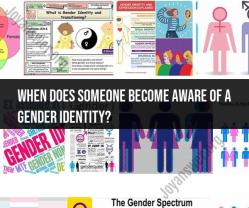When does someone become aware of a gender identity?
Awareness of one's gender identity typically begins to develop during early childhood. It's a gradual process influenced by a combination of biological, social, and personal factors. Here's a general timeline:
Infancy: During the first year of life, infants typically have no concept of gender identity. They primarily focus on basic needs and forming attachments with caregivers.
Toddlerhood (Ages 1-3): Toddlers start to become aware of gender differences, such as noticing the physical distinctions between boys and girls. They may begin to use gendered language (e.g., saying "boy" or "girl") and show interest in gender-stereotyped toys or activities. However, their understanding is still quite basic.
Preschool (Ages 3-5): Gender identity continues to develop as children become more aware of their own gender and that of others. They may start to identify themselves as a boy or a girl and exhibit preferences for clothing, hairstyles, or activities associated with their gender identity. Gender identity at this stage is often cisgender (aligning with one's assigned sex at birth).
Elementary School (Ages 6-12): Children solidify their gender identities during this period. They develop a stronger sense of themselves as boys, girls, or, for some, as a gender different from their assigned sex (gender-diverse or transgender). Gender stereotypes and societal expectations also play a role in shaping their understanding of gender.
Adolescence (Ages 13-18): Adolescents continue to explore and develop their gender identities. Some individuals may question or explore their gender identity during this time. Gender identity can be complex, and some may identify as transgender, non-binary, genderqueer, or other gender identities.
Adulthood: By adulthood, most individuals have a solidified sense of their gender identity. For cisgender individuals, their gender identity aligns with their assigned sex at birth. For transgender and gender-diverse individuals, their gender identity may be different from their assigned sex. Coming out and transitioning may occur during adulthood.
It's essential to recognize that gender identity is a deeply personal and individual experience. Some individuals may have a clear and unwavering sense of their gender identity from a young age, while others may question or explore their gender identity at various stages of life. Supportive and inclusive environments are crucial for individuals to explore and express their gender identity in a healthy and accepting way.


